December 24, 2010 Updated
To all supporters of the AKATSUKI project
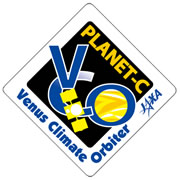 Our Venus Climate Orbiter “AKATSUKI” is believed to have encountered an unexpected accident on Dec. 7 during its Venus orbit insertion, and it was very regrettable that the orbit injection effort failed. All the project members were bitterly disappointed, and all the supporters must feel the same way.
Our Venus Climate Orbiter “AKATSUKI” is believed to have encountered an unexpected accident on Dec. 7 during its Venus orbit insertion, and it was very regrettable that the orbit injection effort failed. All the project members were bitterly disappointed, and all the supporters must feel the same way.Fortunately, we still have maintained contact with the AKATSUKI, thus the mission has not been terminated.
We are, first of all, investigating the cause so that we will not repeat the same mistake in future missions. Meanwhile, we are striving to keep the AKATSUKI flying in a stable manner in its current status, and are doing our utmost to send the brothers and sisters of the AKATSUKI to space someday to acquire precious knowledge for the human race.
I believe this is the mission of us, space scientists, to learn lessons for the future from the experience this time, overcome the failure, and come up with a new mission.
The significance of Venus exploration has never been lost. Until we elucidate the mystery of Venus, we sincerely hope that you will walk with us.
Thank you very much for your support.
Venus Climate Orbiter “AKATSUKI” (PLANET-C) Project Manager
Masato Nakamura
*Updated information will be posted on the AKATSUKI project page when it is available. We would like to send our heartfelt appreciation to all the project supporters.
December 10, 2010 Updated
AKATSUKI takes images of Venus during functional verification
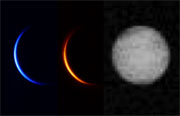 JAXA is currently investigating the failure cause of the Venus orbit injection of the Venus Climate Orbiter “AKATSUKI.” During the course of the orbiter functional verification after data acquisition at the periVenus, we were able to obtain some Venus images captured by the AKATSUKI at around 9:00 a.m. on Dec. 9 (Japan Standard Time.)
JAXA is currently investigating the failure cause of the Venus orbit injection of the Venus Climate Orbiter “AKATSUKI.” During the course of the orbiter functional verification after data acquisition at the periVenus, we were able to obtain some Venus images captured by the AKATSUKI at around 9:00 a.m. on Dec. 9 (Japan Standard Time.)(Images: from left, an image shot by the UVI, IR1, and LIR. The images are artificially colored: The UVI image with blue, and the IR1 image with orange.)
December 8, 2010 Updated
AKATSUKI Venus orbit injection plan to be reviewed
JAXA found that we have failed to inject the Venus Climate Orbiter "AKATSUKI" into the planned Venus orbit after conducting the Venus orbit insertion maneuver (VOI-1) on December 7. While we set up a new investigation team to study the cause and countermeasures, we will also review the Venus orbit injection plan again to take the next opportunity in six years when the AKATSUKI flies closest to Venus.December 8, 2010 Updated
AKATSUKI Venus observation orbit injection result
JAXA conducted the Venus orbit insertion maneuver (VOI-1) for the Venus Climate Orbiter "AKATSUKI" at 8:49 a.m. on December 7 (Japan Standard Time,) but, unfortunately, we have found that the orbiter was not injected into the planned orbit as a result of orbit estimation. The "AKATSUKI" was launched from the Tanegashima Space Center on May 21.JAXA has set up an investigation team to study the cause of the failure.
We will update you with the investigation results and AKATSUKI operation status on the web.
December 6, 2010 Updated
AKATSUKI ready for orbit injection
 The Venus Climate Orbiter "AKATSUKI" shifted its attitude at 7:50 a.m. on December 6 to be ready for Venus orbit insertion at 8:49 a.m. on December 7.
The Venus Climate Orbiter "AKATSUKI" shifted its attitude at 7:50 a.m. on December 6 to be ready for Venus orbit insertion at 8:49 a.m. on December 7.On the 7th, we will hold some events to support the AKATSUKI orbit injection. We plan to run the "Venus arrival live broadcast" featuring the AKTSUKI and show the scene of the AKATSUKI Control Room" at a public viewing site. Please come and join the injection moment. (* All time and dates are Japan Standard Time.)
- AKATSUKI Venus orbit injection support events (Sagamihara Campus)
- Let's support the AKATSUKI through Twitter! (Japanese language only)
December 3, 2010 Updated
Please support AKATSUKI as it enters the Venus Orbit on Dec. 7
 The Venus Climate Orbiter "AKATSUKI" will finally be injected into its Venus orbit on December 7. We are planning some events to support the AKATSUKI project on that day including the "Venus arrival live broadcast" featuring the AKATSUKI project, a public viewing to show the AKATSUKI control room at the time of orbit insertion, and an observation event of Venus with pundits. Your support will be very much appreciated!
The Venus Climate Orbiter "AKATSUKI" will finally be injected into its Venus orbit on December 7. We are planning some events to support the AKATSUKI project on that day including the "Venus arrival live broadcast" featuring the AKATSUKI project, a public viewing to show the AKATSUKI control room at the time of orbit insertion, and an observation event of Venus with pundits. Your support will be very much appreciated!
- AKATSUKI Venus orbit injection support events (Sagamihara Campus)
- Let's support the AKATSUKI through Twitter! (Japanese language only)
November 18, 2010 Updated
Date of AKATSUKI injection to Venus orbit
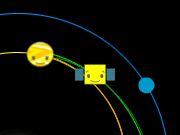 JAXA decided to emit jets from the orbital maneuvering engine (OME) of the AKATSUKI at 8:49:00 a.m. on Dec. 7 (Japan Standard Time, all the following dates and time are in JST) to inject the orbiter into the Venus orbit. Under the current schedule, the OME jet emission will be completed at 9:01:00 a.m. on the same day, and the Venus orbit will be determined around 9:00 p.m. also on the same day after some attitude control maneuvers including the Earth pointing maneuver of the Z axis.
JAXA decided to emit jets from the orbital maneuvering engine (OME) of the AKATSUKI at 8:49:00 a.m. on Dec. 7 (Japan Standard Time, all the following dates and time are in JST) to inject the orbiter into the Venus orbit. Under the current schedule, the OME jet emission will be completed at 9:01:00 a.m. on the same day, and the Venus orbit will be determined around 9:00 p.m. also on the same day after some attitude control maneuvers including the Earth pointing maneuver of the Z axis.The AKATSUKI will study the Venus atmosphere for about two years after being injected into the Venus orbit.
October 25, 2010 Updated
AKATSUKI takes images of Sagittarius using its onboard cameras
 On October 8, the onboard cameras of the AKATSUKI took images of a part of Sagittarius. For this image shooting, we made the AKATSUKI face its cameras' installed side to Sagittarius while the explorer was communicating with the Usuda Deep Space Center, and took images by activating the Longwave IR camera (IRC,) Ultraviolet Image (UVI,) 1µ m camera (IR1,) and 2µ m camera (IR2.)
On October 8, the onboard cameras of the AKATSUKI took images of a part of Sagittarius. For this image shooting, we made the AKATSUKI face its cameras' installed side to Sagittarius while the explorer was communicating with the Usuda Deep Space Center, and took images by activating the Longwave IR camera (IRC,) Ultraviolet Image (UVI,) 1µ m camera (IR1,) and 2µ m camera (IR2.)The AKATSUKI onboard cameras can capture invisible light such as ultraviolet or infrared rays. Thus Sagittarius shot by the UVI, which observes ultraviolet rays, and the IR1, which catches infrared rays, looks different from what the human eye can see.
Concerning the LIR and IR2, it was predicted in advance that they could not detect a star under the observed wave-length region and temperature conditions of the observation this time. We, therefore, confirmed that each camera works properly according to their respective functional conditions.
July 23, 2010 Updated
IKAROS successfully controlled its attitude using liquid crystal device
The Small Solar Power Sail Demonstrator "IKAROS" performed an attitude control experiment of the solar sail using an attitude control device, or the liquid crystal device, on July 13, and JAXA confirmed that the attitude control performance was successfully accomplished as planned.The liquid crystal device is attached to the solar sail for attitude control to change the reflection characteristics of sunlight by turning on and off the power of the device. With this function, the sail can control its attitude using only sunlight pressure without any additional propellant.
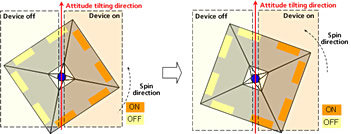
July 14, 2010 Updated
IKAROS observes gamma-ray burst
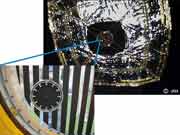 The GPA, or the gamma-ray polarized light detector, which is aboard the Small Solar Power Sail Demonstrator "IKAROS," successfully observed a gamma-ray burst. JAXA will further aim at observing gamma-rays through polarized light observations, which will be a global first if successful. Polarized light observations of gamma-rays will contribute to elucidate the magnetic structure and the radiation system of a gamma-ray burst, thus it is expected to be greatly helpful to solve the mystery of the death of planets and the birth of black holes.
The GPA, or the gamma-ray polarized light detector, which is aboard the Small Solar Power Sail Demonstrator "IKAROS," successfully observed a gamma-ray burst. JAXA will further aim at observing gamma-rays through polarized light observations, which will be a global first if successful. Polarized light observations of gamma-rays will contribute to elucidate the magnetic structure and the radiation system of a gamma-ray burst, thus it is expected to be greatly helpful to solve the mystery of the death of planets and the birth of black holes.
July 9, 2010 Updated
IKAROS: Acceleration by solar sail confirmed
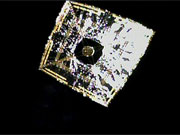 The small solar power sail demonstrator "IKAROS," which successfully deployed its solar sail, was confirmed to accelerate by solar sail receiving solar pressure.
The small solar power sail demonstrator "IKAROS," which successfully deployed its solar sail, was confirmed to accelerate by solar sail receiving solar pressure.This proved that the IKAROS has generated the biggest acceleration through photon during interplanetary flight in history.
July 6, 2010 Updated
AKATSUKI successfully controls orbit by the world's first ceramic thruster
 On June 28 (Japan Standard Time,) the Venus Climate Orbiter “AKATSUKI” successfully jetted the thrust of 500 Newton by its orbital maneuvering engine (OME) at a distance of 14.6 million km from the Earth or 1.06 Astronomical Units (AU) from the sun. The OME was a newly developed ceramic thruster made of silicon nitride (Si3N4.) It is the first time in the world to successfully generate the thrust by the ceramic thruster in space.
On June 28 (Japan Standard Time,) the Venus Climate Orbiter “AKATSUKI” successfully jetted the thrust of 500 Newton by its orbital maneuvering engine (OME) at a distance of 14.6 million km from the Earth or 1.06 Astronomical Units (AU) from the sun. The OME was a newly developed ceramic thruster made of silicon nitride (Si3N4.) It is the first time in the world to successfully generate the thrust by the ceramic thruster in space.This engine is mainly used for retrofiring when the orbiter enters the Venus orbit, and the verification this time enabled us to confirm that the orbit control was carried out as scheduled.
The next orbit control is scheduled to be in early November, and the orbiter will be at the closest point to Venus and injected into the Venus orbit on December 7 (JST.)
June 30, 2010 Updated
IKAROS moving to regular operations
 The Small Solar Power Sail Demonstrator "IKAROS," which successfully deployed the solar power sail, completed its initial operation verification of the necessary mission equipment including power generation of the thin film solar cells.
The Small Solar Power Sail Demonstrator "IKAROS," which successfully deployed the solar power sail, completed its initial operation verification of the necessary mission equipment including power generation of the thin film solar cells.The IKAROS will move to the regular operation phase to carry out measurements of power generation characteristics of the cells, an acceleration experiment by photon pressure, and orbit control verification.
June 28, 2010 Updated
IKAROS successfully shot images also by DCAM1
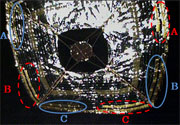 The IKAROS, which deployed the solar sail, took its image by the second separation camera (DCAM1) on June 19 after its successful photo shooting by DCAM2 (the first separation camera.)
The IKAROS, which deployed the solar sail, took its image by the second separation camera (DCAM1) on June 19 after its successful photo shooting by DCAM2 (the first separation camera.)Through the images taken by the DCAM1, we have also confirmed that the liquid crystal device is working properly. The liquid crystal device is equipment whose sunlight reflection characteristics change by turning the power on and off, and it is expected to enable attitude control without using fuel.
We will continue to measure the power generation status of the thin film solar cells attached to the sail, and will verify acceleration by solar sail and orbit control by their acceleration.
June 21, 2010 Updated
Photo shooting by IKAROS separation camera 1 going smoothly
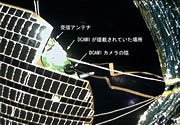 To improve its steering performance, the IKAROS has gradually reduced its rotation speed since June 16, and on the 19th, it released the separation camera 1 (DCAM1) to carry out a photo shooting experiment. The images taken by the DCAM1 are currently being transmitted through downlink, and we were able to confirm a shadow of the camera in the very first image shot by the DCAM1.
To improve its steering performance, the IKAROS has gradually reduced its rotation speed since June 16, and on the 19th, it released the separation camera 1 (DCAM1) to carry out a photo shooting experiment. The images taken by the DCAM1 are currently being transmitted through downlink, and we were able to confirm a shadow of the camera in the very first image shot by the DCAM1.
June 16, 2010 Updated
Successful image shooting of solar sail by IKAROS separation camera
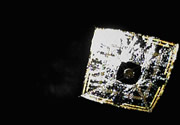 The small solar power sail demonstrator "IKAROS," which expanded its solar sail on June 10, released its separation camera and took images of the deployed solar sail successfully.
The small solar power sail demonstrator "IKAROS," which expanded its solar sail on June 10, released its separation camera and took images of the deployed solar sail successfully.We will continue to measure the power generation status of the thin film solar cells attached to the sail, and will verify acceleration by the cells and orbit control by their acceleration.
June 11, 2010 Updated
IKAROS successfully deploys sail!
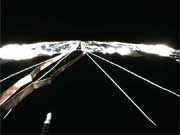 The Small Solar Power Sail Demonstrator "IKAROS" launched by the H-IIA F17 began to deploy its sail on June 3 (Japan Standard Time, JST,) and on June 10 (JST,) JAXA confirmed the proper extension of the sail and power generation by the thin film solar cells at about 7.7 million km from the Earth.
The Small Solar Power Sail Demonstrator "IKAROS" launched by the H-IIA F17 began to deploy its sail on June 3 (Japan Standard Time, JST,) and on June 10 (JST,) JAXA confirmed the proper extension of the sail and power generation by the thin film solar cells at about 7.7 million km from the Earth.We will continue to measure the power generation status of the cells attached to the sail, and will verify acceleration by the cells and orbit control by their acceleration.
May 23, 2010 Updated
AKATSUKI/IKAROS flying smoothly!
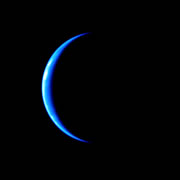 On May 21, JAXA confirmed that the Venus Climate Orbiter "AKATSUKI,"
On May 21, JAXA confirmed that the Venus Climate Orbiter "AKATSUKI,"launched by the H-IIA F17, successfully performed a sequence of scheduled operations such as the deployment of the solar array paddles and sun acquisition.
We have also received earth images taken by the AKATSUKI while verifying the condition of onboard devices at about 250,000 km above the Earth at around 8:50 p.m. on May 21.
The Small Solar Power Sail Demonstrator "IKAROS," which was also launched by the H-IIA F17 with the AKATSUKI, was also confirmed to have successfully generated power through the solar batteries and stabilized its correct posture. Accordingly, communications were established with the IKAROS.
May 21, 2010 Updated
AKATSUKI successfully launched!!
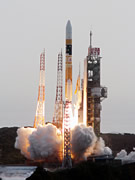 The H-IIA Launch Vehicle No. 17 (H-IIA F17) with the Venus Climate Orbiter "AKATSUKI" onboard was launched at 6:58:22 a.m. on May 21 (Japan Standard Time) from the Tanegashima Space Center. The H-IIA F17 flew smoothly, and, at 27 minutes and 29 seconds after liftoff, the AKATSUKI was separated from the H-IIA.
The H-IIA Launch Vehicle No. 17 (H-IIA F17) with the Venus Climate Orbiter "AKATSUKI" onboard was launched at 6:58:22 a.m. on May 21 (Japan Standard Time) from the Tanegashima Space Center. The H-IIA F17 flew smoothly, and, at 27 minutes and 29 seconds after liftoff, the AKATSUKI was separated from the H-IIA.We will update you with the latest information on the AKATSUKI on the special site.
(Photo: Mitsubishi Heavy Industries)
May 20, 2010 Updated
H-IIA F17 with AKATSUKI/IKAROS onboard moved to Launch Pad 1 again
 The H-IIA Launch Vehicle No. 17 with the Venus Climate Orbiter “AKATSUKI” and the Small Solar Power Sail Demonstrator “IKAROS” onboard was transported back to the Vehicle Assembly Building (VAB) after its launch delay had been decided. At around 1:00 p.m. on the 20th, the launch vehicle was moved again to Launch Pad 1. Final preparations, including propellant loading, will be carried out to be ready for the launch at 6:58:22 a.m. on the 21st (Fri.)
The H-IIA Launch Vehicle No. 17 with the Venus Climate Orbiter “AKATSUKI” and the Small Solar Power Sail Demonstrator “IKAROS” onboard was transported back to the Vehicle Assembly Building (VAB) after its launch delay had been decided. At around 1:00 p.m. on the 20th, the launch vehicle was moved again to Launch Pad 1. Final preparations, including propellant loading, will be carried out to be ready for the launch at 6:58:22 a.m. on the 21st (Fri.)The live launch report broadcast will begin at 6:30 a.m. on the 21st. The report will also be broadcast at JAXA i, Sagamihara Campus and other public viewing locations including some universities. We are welcoming support messages, and we also welcome any launch photos taken by the public. If you are able to take some nice photos of the launch, please send them to JAXA.
* The live report schedule is subject to change due to the launch preparation status and weather conditions.
- Live Broadcast
- Countdown Report (Mitsubishi Heavy Industries)
- Support messages (Japanese language only)
- Launch photos (Japanese language only)
May 18, 2010 Updated
AKATSUKI/IKAROS Launch rescheduled to 6:58 a.m. on the 21st (Fri)
 The launch of the Venus Climate Orbiter "AKATSUKI" and the Small Solar Power Demonstrator "IKAROS" by the H-IIA Launch Vehicle No. 17 was rescheduled at 6:58:22 a.m. on May 21 (Fri. Japan Standard Time, JST) after carefully studying the weather conditions.
The launch of the Venus Climate Orbiter "AKATSUKI" and the Small Solar Power Demonstrator "IKAROS" by the H-IIA Launch Vehicle No. 17 was rescheduled at 6:58:22 a.m. on May 21 (Fri. Japan Standard Time, JST) after carefully studying the weather conditions.Accordingly, the live launch report will begin at 6:30 a.m. on May 21(Fri., JST.) The report will be broadcast not only through the Internet, but also at JAXA i, Sagamihara Campus and other public viewing locations including some universities. You can also watch it through some CATV and cell phone providers.
May 18, 2010 Updated
AKATSUKI/IKAROS launch postponement
 H-IIA Launch Vehicle No.17 with the Venus Climate Orbiter "AKATSUKI" and "IKAROS" onboard was scheduled to be launched on the 18th, but due to clouds including a freezing layer exceeding launch restrictions for weather around the launch site, the launch was postponed.
H-IIA Launch Vehicle No.17 with the Venus Climate Orbiter "AKATSUKI" and "IKAROS" onboard was scheduled to be launched on the 18th, but due to clouds including a freezing layer exceeding launch restrictions for weather around the launch site, the launch was postponed.The new launch day will be announced as soon as it is determined.
May 17, 2010 Updated
H-IIA F17 with AKATSUKI and IKAROS onboard moved to Launch Pad 1
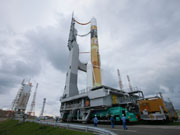 The H-IIA Launch Vehicle No. 17 with the Venus Climate Orbiter "AKATSUKI" and the Small Solar Power Sail Demonstrator "IKAROS" onboard left the Vehicle Assembly Building at 6:01 a.m. on the morning of the 17th (Japan Standard Time, JST) and arrived at the Launch Pad 1 at 6:25 a.m. (JST.) We will load propellant to be ready for the launch at 6:44:14 a.m. on the 18th (Tue., JST)
The H-IIA Launch Vehicle No. 17 with the Venus Climate Orbiter "AKATSUKI" and the Small Solar Power Sail Demonstrator "IKAROS" onboard left the Vehicle Assembly Building at 6:01 a.m. on the morning of the 17th (Japan Standard Time, JST) and arrived at the Launch Pad 1 at 6:25 a.m. (JST.) We will load propellant to be ready for the launch at 6:44:14 a.m. on the 18th (Tue., JST) We will begin the Internet Live Report of the H-IIA launch from 6:15 a.m. on the 18th (JST.) The report will also be broadcasted at JAXA i, Sagamihara Campus, and other public viewing locations including some universities. Please enjoy dynamic images of the launch from the Tanegashima Space Center, and support the mission.
We will also welcome launch photos taken by you. If you are able to take some nice photos of the launch, please send them to JAXA.
* The live report schedule is subject to change due to the launch preparation status and weather conditions.
- Live Broadcast
- Countdown Report (Mitsubishi Heavy Industries)
- Support messages (Japanese language only)
- Launch photos (Japanese language only)
May 11, 2010 Updated
Live launch report of AKATSUKI and IKAROS from 6:15 a.m. on the 18th
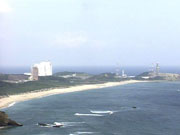 On May 18, the Venus Climate Orbiter "AKATSUKI" and the Small Solar Power Sail Demonstrator "IKAROS" will be launched by the H-IIA Launch Vehicle No. 17. The two payloads are now under final preparations at the Vehicle Assembly Building (VAB).
On May 18, the Venus Climate Orbiter "AKATSUKI" and the Small Solar Power Sail Demonstrator "IKAROS" will be launched by the H-IIA Launch Vehicle No. 17. The two payloads are now under final preparations at the Vehicle Assembly Building (VAB).We will broadcast the live launch report through the Internet from the Tanegashima Space Center (TNSC). The live report will begin at 6:15 a.m. on the 18th (Tue.) We will also broadcast the live launch report at JAXA i, Sagamihara Campus and other public viewing sites including universities. Please enjoy the dynamic image of the launch from the TNSC and support the mission.
We also welcome support messages to the AKATSUKI and IKAROS project teams.
* Please be aware that the live launch report schedule is subject to change due to the preparation status and weather conditions.
May 10, 2010 Updated
AKATSUKI and IKAROS moved to VAB
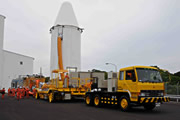 On May 9, the encapsulated Venus Climate Orbiter "AKATSUKI" and the Small Solar Power Sail Demonstrator "IKAROS" were transported to the Vehicle Assembly Building (VAB), where the H-IIA Launch Vehicle No. 17 was waiting for their payloads. They will be loaded onto the launch vehicle, and the final inspection will be carried out to be ready for the launch on the 18th.
On May 9, the encapsulated Venus Climate Orbiter "AKATSUKI" and the Small Solar Power Sail Demonstrator "IKAROS" were transported to the Vehicle Assembly Building (VAB), where the H-IIA Launch Vehicle No. 17 was waiting for their payloads. They will be loaded onto the launch vehicle, and the final inspection will be carried out to be ready for the launch on the 18th.
May 6, 2010 Updated
AKATSUKI encapsulated in the fairing
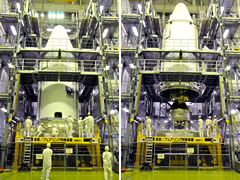 On May 4, the Venus Climate Orbiter "AKATSUKI" and the Small Solar Power Sail Demonstrator "IKAROS" were encapsulated in the fairing at the Spacecraft and Fairing Assembly Building (SFA) at the Tanegashima Space Center (TNSC.) The fairing covers the payloads to protect them from air resistance, friction heat, and acoustic vibrations during launch.
On May 4, the Venus Climate Orbiter "AKATSUKI" and the Small Solar Power Sail Demonstrator "IKAROS" were encapsulated in the fairing at the Spacecraft and Fairing Assembly Building (SFA) at the Tanegashima Space Center (TNSC.) The fairing covers the payloads to protect them from air resistance, friction heat, and acoustic vibrations during launch.The encapsulated payloads will be transported to the Vehicle Assembly Building and loaded on to the H-IIA Launch Vehicle No. 17.
April 30, 2010 Updated
AKATSUKI mated with the PAF
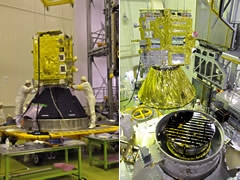 On April 30, the Venus Climate Orbiter "AKATSUKI" was mated with the Payload Attach Fitting (PAF,) which connects the AKATSUKI and the launch vehicle, at the Spacecraft and Fairing Assembly Building (SFA) at the Tanegashima Space Center (TNSC.)
On April 30, the Venus Climate Orbiter "AKATSUKI" was mated with the Payload Attach Fitting (PAF,) which connects the AKATSUKI and the launch vehicle, at the Spacecraft and Fairing Assembly Building (SFA) at the Tanegashima Space Center (TNSC.)The Small Solar Power Sail Demonstrator "IKAROS," a co-payload of the AKATSUKI, has already been packed in the PAF.
The AKATSUKI will be encapsulated in the fairing, and transported to the Vehicle Assembly Building (VAB) to be loaded onto the H-IIA Launch Vehicle No. 17.
April 21, 2010 Updated
Support the launch with a poster, leaflet, or computer wallpaper!
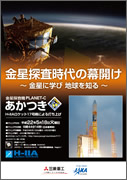 The poster and leaflet for the launch of AKATSUKI by H-IIA Flight 17 are ready.
The poster and leaflet for the launch of AKATSUKI by H-IIA Flight 17 are ready.We have also prepared wallpapers for a computer and browser dress-up (Firefox.)
Why don't you place a poster in your room, office or classroom, and put wallpaper on your PC desktop to support the launch!
- Poster (PDF : 468KB, Japanese language only)
- Leaflet (PDF : 2MB, Japanese language only)
- Wallpaper and paper craft
March 19, 2010 Updated
AKATSUKI arrives at the Tanegashima Space Center
 The Venus Climate Orbiter "AKATSUKI," which left the Sagamihara Campus on March 17, arrived at the Spacecraft Test and Assembly Building 2 (STA2) at the Tanegashima Space Center at 5:30 p.m. on the 19th.
The Venus Climate Orbiter "AKATSUKI," which left the Sagamihara Campus on March 17, arrived at the Spacecraft Test and Assembly Building 2 (STA2) at the Tanegashima Space Center at 5:30 p.m. on the 19th.
March 18, 2010 Updated
AKATSUKI leaves for Tanegashima
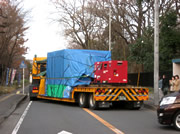 The Venus Climate Orbiter "AKATSUKI" left the Sagamihara Campus for theTanegashima Space Center (TNSC) on the evening of March 17.
The Venus Climate Orbiter "AKATSUKI" left the Sagamihara Campus for theTanegashima Space Center (TNSC) on the evening of March 17.The AKATSUKI will be delivered to the TNSC on the 19th. It will undergo final launch preparations there.
March 12, 2010 Updated
AKATSUKI and IKAROS open to the media at Sagamihara Campus
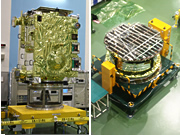 On March 12, the Venus Climate Orbiter "AKATSUKI" and the Small Solar Power Sail Demonstrator "IKAROS" were displayed to the media at the Sagamihara Campus.
On March 12, the Venus Climate Orbiter "AKATSUKI" and the Small Solar Power Sail Demonstrator "IKAROS" were displayed to the media at the Sagamihara Campus.The two payloads will be transported to the Tanegashima Space Center to be ready for launch.
The IKAROS message campaign, Solar Sail Mission Support Campaign "Let's set sail for the solar system on a solar yatch!," has been extended until March 22, (Monday and a holiday in Japan for Vernal Equinox Day.) Those who have not registered, don't miss this opportunity!
March 3, 2010 Updated
"AKATSUKI" launch date set! Special site open
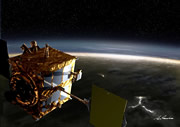 The launch time and day of the H-IIA Launch Vehicle No. 17 (H-IIA F17) has been set for 6:44:14 a.m. on May 18. The H-IIA will carry the Venus Climate Orbiter "AKATSUKI," the Small Solar Power Sail Demonstrator "IKAROS," and four other small satellites to space.
The launch time and day of the H-IIA Launch Vehicle No. 17 (H-IIA F17) has been set for 6:44:14 a.m. on May 18. The H-IIA will carry the Venus Climate Orbiter "AKATSUKI," the Small Solar Power Sail Demonstrator "IKAROS," and four other small satellites to space.The AKATSUKI special website opens today to keep you updated about its preparation status before its arrival to the Venus orbit. Please enjoy the site.
